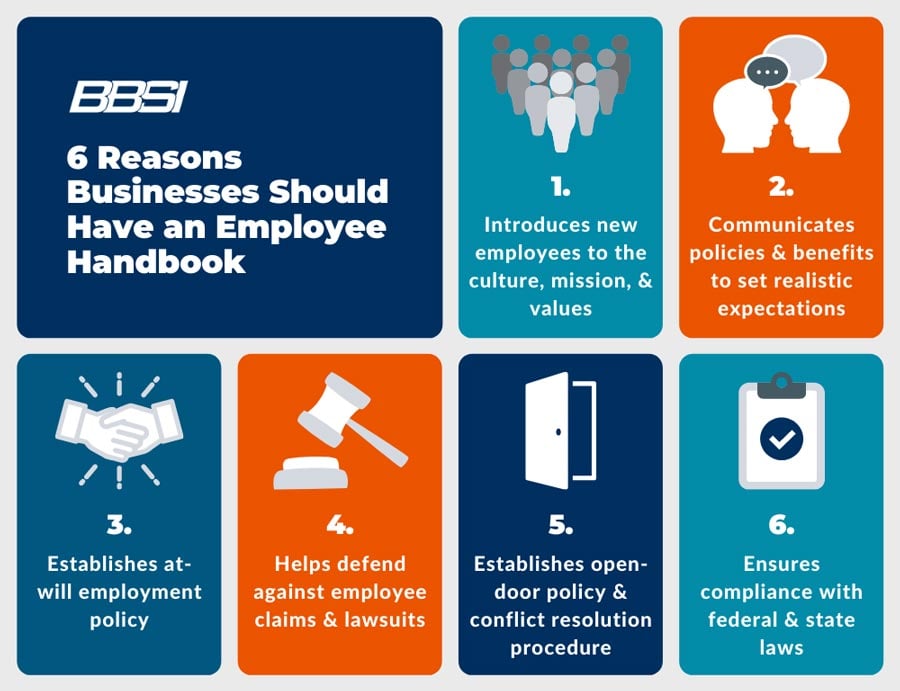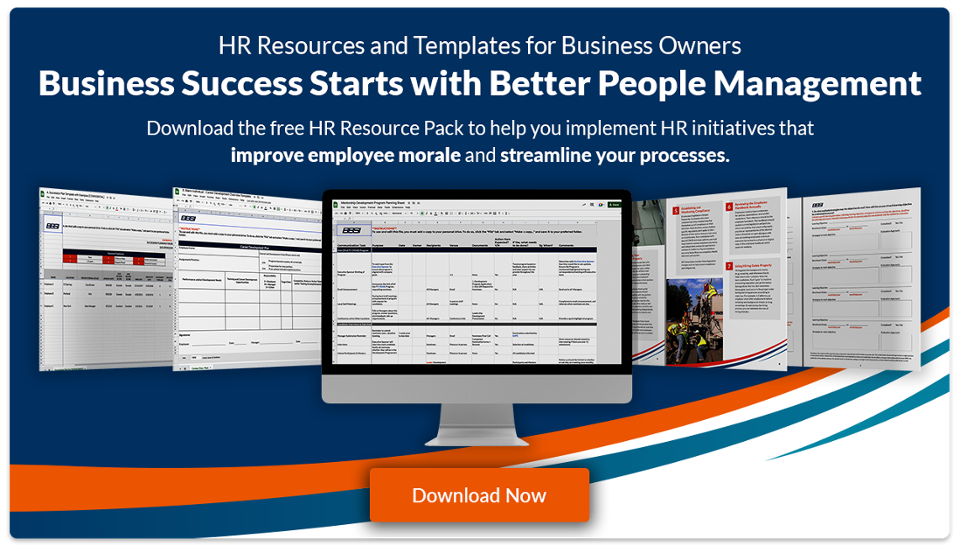
Why You Should Create an Employee Handbook and How to Get Started
An employee handbook is arguably one of the most important documents a business should have, regardless of company size or industry.
When a company lacks critical documentation of its policies and procedures, it can create a knowledge gap in the organization and open it up to problems, such as poor company culture or increases in false workers’ compensation claims from disgruntled employees. An employee handbook outlines clear expectations for both the employer and the employees and sets an organization-wide precedent for appropriate conduct and benefits.
This blog will discuss the requirements, advantages, and structure of an employee handbook, as well as some best practices for creating and maintaining one.
TABLE OF CONTENTS
What is an Employee Handbook?
Simply put, an employee handbook is a document that clearly outlines a company’s policies, procedures, and general company culture. It defines the rules that guide employer-employee relationships and contains detailed information about employees’ rights and benefits. It also contains clear expectations for employee behavior and enforcement of company policies.
Are Employers Required to Provide an Employee Handbook?
No, there aren’t any laws that require businesses to provide an employee handbook. However, some states do require companies to have and provide their employees with specific written policies. While they aren’t legally required, handbooks are highly recommended for all businesses, no matter their size or industry.
Why Should Businesses Have an Employee Handbook?
Some of the benefits of creating an employee handbook include the following.

1. Introduces New Employees to the Company’s Culture, Mission, and Values
An employee handbook serves as a crucial introduction tool for new employees during their onboarding, as it establishes a company’s norms and gives employees a central place to learn about the company's mission, culture, and values. This helps employers set a precedent for how individuals should interact within the company from day one.
A handbook also helps set the tone for an employment relationship and sends a clear message to employees that the company has put care into establishing and documenting programs intended to make their jobs better.
2. Communicates Key Company Policies and Benefits to Set Realistic Employee and Employer Expectations
As we’ve briefly mentioned, an employee handbook details and outlines the expectations for both the employer and the employee in terms of behavior, benefits, and culture.
Clarification goes a long way in ensuring employees’ knowledge of benefits they are entitled to, policies they are expected to adhere to, and everything else they can expect during their time in the organization. Making these critical topics clear helps to avoid unrealistic employee expectations and can even improve employee morale. When employees know what their company expects and what they have access to, they're more likely to have higher job satisfaction.
Communicating key policies also helps prevent managers from fabricating and enforcing policies that go against the company’s set practices. Effective communication of the practices, benefits, and policies sets the groundwork for realistic expectations on all sides.
3. Establishes an At-Will Employment Policy
An at-will employment policy is a provision that states an employer or employee can terminate the employment relationship at any time for any reason or no reason at all. However, at-will employment does not warrant discriminatory termination on the basis of things like age, race, gender, sexual orientation, national origin, disability, religion, and genetic information, among others.
4. Helps Defend the Company Against Employee Claims and Lawsuits
Creating an employee handbook shows that you exercise reasonable care toward your employees. Additionally, if an employee files a lawsuit or makes a claim that contradicts a documented and enforced procedure, the handbook can be a source of defense against false claims. For instance, if an employee says they are entitled to holiday pay and the handbook clearly states that they are not, the company is most likely not obligated to make any payment.
By setting clear expectations, companies also reduce the chances of lawsuits from the moment of hire. New employees fully understand their benefits at the time of orientation which can potentially avoid any legal action at a later date.
5. Establishes an Open-Door Policy and Conflict Resolution Procedure
An employee handbook provides employees with a clear communication path and gives them information about where they can get help should they encounter problems in the workplace.
A clear communication path helps the company deal with conflicts as they arise because as soon as there’s an issue, employees should know who to go to. If there’s no clarification about who to approach in the event of a problem, things could worsen before management becomes aware.
In some cases, employees may choose to contact an outside agency instead of alerting their company. This will often escalate an issue that could have been resolved internally had management been made aware of the problem. If an employee goes to a third party, the company may also face repercussions from regulatory bodies such as OSHA, the EOC, and the DFEH, among others.
Establishing and communicating an open-door policy and conflict resolution procedure helps create a culture that gives employees a sense of safety and adds to their overall satisfaction, while also giving companies the opportunity to rectify issues before they escalate.

6. Ensures Compliance with Federal and State Laws
As previously mentioned, state and federal law does require employers to provide employees with certain written policies. Some of these policies include:
- Family Medical Leave Act
- Equal Opportunity Employment
- Title VII of the Civil Rights Act
- Title I of the ADA
- Pregnancy Disability Leave
- FEHA guidelines
Similar to how FEHA language prohibits discrimination, these policies ensure equal opportunities and fair treatment for everyone.
Download the Employee Handbook Template
What Should Be Included in an Employee Handbook?
While there is no specific format for employee handbooks, there are some critical sections employers should include, such as:
1. The Company’s History, Vision, Mission Statement, and Core Values
As mentioned, this is a great way to introduce employees to a company and its leadership, and clearly explain what the company stands for. Including a brief history, an organizational chart, and the company’s future plans help employees feel welcome and understand how they fit into the company overall.
2. At-Will Statement
As stated above, the at-will statement allows both parties to terminate the employment relationship at any time for any reason, provided it is not discriminatory. Establishing at-will employment benefits both the employer and the employee because it specifies neither party is obligated to continue the working relationship if it no longer serves the best interests of the company or individual.
3. Code of Conduct and Company Policies
The Code of Conduct section establishes a company’s expectations for employee behavior. Here, the company can share its zero-tolerance policies for things such as violence, workplace bullying, drug use, and harassment. Companies should also include their policies for internet use, social media, and guidelines for communication in the workplace.
4. Working Hours, Dress Code, and Facility Information
The company should specify any extra workplace policies such as working hours and dress code so all employees are on the same page. The company should also provide employees with information regarding outside employment, on-premise smoking, ergonomics, and cell phone policies. Some companies may choose to include more niche requirements such as a fragrance policy that limit employees from wearing certain perfumes or colognes.
Additionally, this section should include any guidelines or response plans around natural disasters, public health emergencies, or long-term changes that came from the COVID-19 pandemic, such as remote work and sanitation policies.

5. Wage and Overtime Information
In this section of the handbook, companies should discuss things like employee classification, payment of wages, meal and rest periods, and overtime policies for non-exempt employees. This is an important section that clarifies what employees should expect in terms of compensation and benefits like promotions.
6. Privacy and Security Information
Here, the handbook should outline the employees’ personal privacy rights in the workplace. Companies should detail their procedures, policies, and practices regarding the collection, storage, and disclosure of employees’ personal data.
7. Federal and State Mandates Impacting Employees
Federal and state mandates can exist as a separate section, or they can be incorporated throughout the handbook. However the information is presented, companies need to cover state-specific as well as federally-mandated policies.
8. Benefits for Full-Time and Part-Time Employees
Companies should provide information on the various benefits they offer, such as dental, vision, and retirement plans like a 401(k). It should also summarize health insurance, life insurance, and any other employee assistance programs the company offers.
9. Time Off and Leaves of Absence
This section should cover topics like paid time off, vacation time, sick time, and bereavement. It should also discuss in detail the requirements and process for taking each leave of absence employees are entitled to.
10. Resignation and Termination Processes
Here, companies should give detailed information about what their employees can expect before, during, and after termination from the company. It should also include the company’s disciplinary procedures and any prohibited behaviors that could lead to termination such as coming to work under the influence.
11. Acknowledgment of Receipt
An acknowledgment of receipt is a document that employees sign to indicate they have received and read the employee handbook. While it does not act as a legal document, it is proof a company made the employee aware of the company’s policies, guidelines, and expectations.
How Do You Create an Employee Handbook?
Creating an employee handbook can feel like an overwhelming process. Here are seven steps to help you get started.
Step 1: Know and understand relevant state and federal laws
Step 2: Compile and review your current policies
Step 3: Create an outline
Step 4: Write your policies and procedures
Step 5: Have an employment law attorney review your handbook
Step 6: Decide how to distribute your handbook to your employees
Step 7: Get employee acknowledgment of receipt
Step 1. Know the Law
Before creating an employee handbook, familiarize yourself with state and federal law and understand any changes that have been adopted since the last time you reviewed your handbook or written policies. Often, court case decisions come up that change how different laws are applied or interpreted, which may require revisions to relevant policies in your handbook.
Step 2. Compile and Review Current Policies
After familiarizing yourself with the law, you should review all documented and undocumented policies to determine what still applies to your organization and what needs to be updated.
Step 3. Create an Outline
While there isn’t one reigning handbook structure, you can choose to work off a template to make the process easier. If you decide to start with a template, make sure to only choose the sections and policies that are relevant to your company or legally required, and omit those that are not.
While creating your handbook outline, make sure to consider creating policies that will attract the right talent to your company and policies your employees will embrace. For example, if you want to hire professionals in younger generations, consider embracing a flexible work structure if it fits your industry and business model.
Step 4. Write Your Policies and Procedures
This is the most crucial step in the handbook creation process. Your policies and procedures will be the most crucial information outlined in your handbook. Be sure to avoid ambiguities and provide detailed information while also keeping the descriptions concise. You can also choose to include visuals where appropriate.
Step 5. Have an Employment Law Attorney Review Your Handbook
Once you’ve written and reviewed all your policies and procedures, it’s highly recommended to have it reviewed by an employment law attorney. Having an experienced professional review your handbook in the final draft stage will ensure that there aren’t ambiguous or vague statements that could expose the company to risk.
Are you concerned about risk mitigation? Contact a BBSI Risk & Safety Consultant.

Step 6. Decide How To Distribute Your Handbook to Employees
Once you have finalized the handbook, you should decide how to distribute it to your employees. If you choose to distribute it electronically, you should send it as a protected PDF or as an ePub document so it cannot be altered. You must also provide a physical copy to any employee who requests one or doesn’t have access to the Internet.
Whether you send it out electronically or print physical copies, you should choose the most convenient distribution method for your employees and the company.
Step 7. Get Employee Acknowledgement of Receipt
You should require every employee to provide a written acknowledgment indicating they received the handbook. You should also include the acknowledgments in each employee’s personnel file as a means for the organization to confirm the employee was made aware of company policies.
Best Practices for Creating and Implementing Employee Handbooks
The work doesn’t stop after creating and distributing your employee handbook. Here are some best practices to help ensure your handbook always remains effective.
Cut Fluff and Unnecessary Policies
If you work off a template, only include policies that apply to your company. Irrelevant policies add fluff to your handbook and once you’ve added a policy, you have to enforce it. For example, if you add a remote work policy but a majority of your workforce has to be on-site to do their job, you open yourself up to various employee interpretations.
[Blog] Making Job Sites Safer with Behavioral Safety Awareness
Utilize Your Handbook During Onboarding and Leadership Training
Everyone in your organization should know your company’s policies and procedures. You should utilize your handbook at every stage of employee development — from onboarding to leadership training. While new employees need the handbook to learn about the company and get acclimated, supervisors and leaders need it to learn how to talk to their employees in a way that reflects the voice of the company. From top to bottom, your handbook is a critical culture development tool.
Enforce What You’ve Outlined
You shouldn’t write your handbook and shelf it. Instead, it should act as your north star and be considered during any relevant conversation or decision. Your handbook should act as a reference point for managers and supervisors to ensure compliance, set standards, and maintain consistency in handling things.
Review Your Handbook Annually and Establish a Timeline for Editing and Redistribution
Laws change and new laws are signed every year. It’s essential to review your handbook at least annually to update any policies to reflect these changes and redistribute them to your employees. A good time to review and update handbooks is in January when all new laws usually take effect. Your policies should reflect these changes to stay in compliance with any mandates.
Send Out Addendums for Minor Changes and Updates
Some years you may only make minor changes that don’t warrant a re-distribution of the entire handbook. Whether the changes originate from internal policies or external legislation, you may only need to send out an addendum that clearly outlines your policies' changes or additions.
How BBSI Helps Businesses Create Critical Documentation
Now that you know the value of an employee handbook and some of the best practices for creating and implementing one, the next step is to create your own. You can choose to utilize resources and build your handbook by yourself, or you have the option of bringing in professional help.
At BBSI, we work with businesses to help create employee handbooks and other critical documentation that mitigate risk and improve company culture. Our local Business Unit Teams build close working relationships with companies to help them overcome obstacles and achieve their goals.
When you partner with BBSI, your dedicated HR Consultant will work with you to document your policies and procedures, as well as keep you updated on all employment legislation and changes that directly impact your business.
Contact your local branch if you’re ready to dive into creating critical documentation for your company.
Disclaimer: The contents of this white-paper/blog have been prepared for educational and information purposes only. Reference to any specific product, service, or company does not constitute or imply its endorsement, recommendation, or favoring by BBSI. This white-paper/blog may include links to external websites which are owned and operated by third parties with no affiliation to BBSI. BBSI does not endorse the content or operators of any linked websites, and does not guarantee the accuracy of information on external websites, nor is it responsible for reliance on such information. The content of this white-paper/blog does not provide legal advice or legal opinions on any specific matters. Transmission of this information is not intended to create, and receipt does not constitute, a lawyer-client relationship between BBSI, the author(s), or the publishers and you. You should not act or refrain from acting on any legal matter based on the content without seeking professional counsel.


